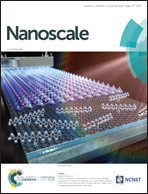A sequentially responsive and structure-transformable nanoparticle with a comprehensively improved ‘CAPIR cascade’ for enhanced antitumor effect†
Abstract
An intravenously administered drug delivery system should undergo a five-step ‘CAPIR’ cascade (circulation, accumulation, penetration, internalization and release), and the maximal efficiency of each step is of great importance to obtain the improved final therapeutic benefits and overall survival rate. Here, a pH/matrix metalloproteinase-9 (MMP9) sequentially responsive and continuously structure-transformable nanoparticle assembled from a doxorubicin (DOX)-conjugated peptide was exploited for comprehensively improving the ‘CAPIR cascade’ and eventually enhancing the therapeutic efficacy. The chimeric peptide can self-assemble into spherical nanoparticles (RGD-sNPs) at pH 7.4 with a particle size of 45.7 ± 5.4 nm. By a combination of passive and active targeting mechanisms, RGD-sNPs achieved efficient accumulation at the tumor site (∼15.1% ID g−1 within 24 h). Both in vitro and in vivo experiments revealed that RGD-sNPs can be transformed into rod-like nanoparticles (S-NFs) triggered by MMP9 that overexpressed in the tumor microenvironment, demonstrating remarkable advantages of deep tumor penetration, prolonged drug retention with ∼3.7% ID g−1 at 96 h, and 2-fold enhanced internalization. Subsequently, S-NFs would respond to the intracellular weakly acidic stimuli to rapidly release DOX for induction of cytotoxicity and apoptosis. Meanwhile, the remaining peptide was further converted into long fibers (length >5 μm) with significant cytotoxicity, thereby exerting a synergistic antitumor effect. Thus RGD-sNPs displayed superior antitumor efficacy and extended the median survival period to 55 days. This provides a new horizon for the exploration of high-performance antitumor nanomedicines.



 Please wait while we load your content...
Please wait while we load your content...